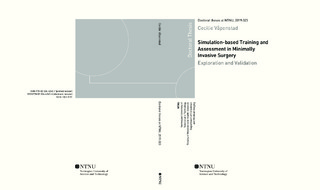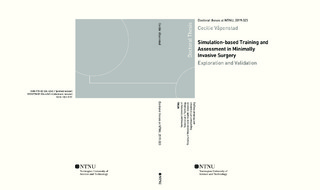| dc.contributor.advisor | Aadahl, Petter | |
| dc.contributor.advisor | Hernes, Toril A. Nagelhus | |
| dc.contributor.advisor | Mårvik, Ronald | |
| dc.contributor.author | Våpenstad, Cecilie | |
| dc.date.accessioned | 2020-02-07T08:36:23Z | |
| dc.date.available | 2020-02-07T08:36:23Z | |
| dc.date.issued | 2019 | |
| dc.identifier.isbn | 978-82-326-4243-4 | |
| dc.identifier.issn | 1503-8181 | |
| dc.identifier.uri | http://hdl.handle.net/11250/2640166 | |
| dc.description.abstract | Changes in surgical techniques and public attention to surgeons’ competencies in general, created a growth in simulation-based training in the late 90’s. The introduction of minimally invasive surgery, with its distinct set of techniques, gave a breeding ground to new ideas for acquisition of surgical skills outside of the operating room thus reducing the reliance on patients for surgical training. In parallel, an increase in adverse events following the introduction of laparoscopy and landmark cases revealing lack of external control, triggered a desire from healthcare management and other stakeholders to assure, through objective assessment, that surgeons have the skills and competencies necessary to perform surgery safely. In addition, organizational changes due to increased pressures on improved efficiency and reduced working hours, have altered the premises for the traditional apprenticeship model. In this context, the development of simulation-based training that reproduce vital parts of the surgical reality appeared as a promising adjunct to the apprenticeship model. Competency-based education, using simulators to assess surgical skills could fulfil patients’ and healthcare managements’ demand for greater accountability. However, simulationbased training and assessment require simulators that have enough support of validity for the intended use. Simulation-based training and assessment raises questions of whether training on simulators transfer to improved clinical performance and whether documented simulator competence equal clinical competence. The main objectives of this thesis were to contribute to the inquiry of these questions. In Paper 1 we explored operators’ appraisal of haptic feedback devices on a virtual reality (VR) simulator for laparoscopy, and investigated whether performance scores on simulators with and without haptic feedback differed. Twenty surgeons performed two tasks using two handles with and without haptic feedback in a blinded randomized cross-over set-up. Seventy-nine percent of the surgeons answered that haptic feedback is important, and eighty-five percent of the surgeons said they achieved better performance scores with handles without haptic feedback. In Paper 2 we explored procedural VR simulation in laparoscopy, endovascular surgery and flexible gastrointestinal endoscopy, through a literature review and an online questionnaire answered by simulator companies. The five simulator companies that answered had 78 procedural tasks, where only 17 of them were found in the literature review having been part of a validation study. We found that hardware-software combinations were sufficiently described in only 12 out of 116 retrieved articles. A large number of procedural tasks were available for training and further were in the pipeline, but most of them were still not part of studies investigating their validity. Paper 3 and 5 investigated whether documented simulator competence correspond with clinical competence for two different simulators: a VR simulator and a box trainer. Surgeons with different levels of experience tested two tasks on the VR simulator with haptics and four tasks on the box trainer with motion tracking. The tasks on the VR simulator and two of the tasks on the box trainer were not able to distinguish between levels of experience. This was probably due to limited physical resemblance of the haptic feedback on the VR simulator or the surgical space in the box trainer. The precision cutting and suture task was able to distinguish between the different groups; while the precision cutting task distinguished between novices and the two other groups, the suture task distinguished between experts and the two other groups, showing that the timing of an assessment task is important. Paper 4 investigated transfer of skills from a VR simulator with haptics to a clinical setting. An experimental group (N=16) trained on the simulator until they attained predefined score levels on the simulator, before they and a control group (N=14) performed a cholecystectomy on a porcine organ model in a box. Their videos were rated by two expert surgeons blinded to training status. The control group got significantly better scores on three out of four categories: “depth perception”, “bimanual dexterity” and “efficiency”. There was no difference between the groups for the fourth category: “tissue handling”. We believe additional friction in the haptic handles resulted in a negative training effect. In conclusion, this thesis has explored and validated simulation-based training and assessment in minimally invasive surgery. It was found that several VR simulated procedures are available on the market for training, though only a limited number have been part of a validation study. The validation studies often inadequately described the handles that were used. We found that training on haptic feedback with unrealistic friction resulted in a negative training effect. Presented in three of the papers, we found that haptic feedback is an essential part of VR simulators, and a feature that developers are struggling to make realistic enough. Further it was observed that assessment tasks should be adapted to level of training. Simulation-based training and assessment has unleashed potential both due to political and organizational aspects on one hand and potential technological improvements and educational evaluation on the other. | |
| dc.language.iso | eng | nb_NO |
| dc.publisher | NTNU | nb_NO |
| dc.relation.ispartofseries | Doctoral theses at NTNU;2019:323 | |
| dc.relation.haspart | Paper 1:
Våpenstad, Cecilie; Hofstad, Erlend Fagertun; Langø, Thomas; Mårvik, Ronald; Chmarra, Magdalena Karolina.
Perceiving haptic feedback in virtual reality simulators. Surgical Endoscopy 2013 ;Volum 27.(7) s. 2391-2397
https://doi.org/10.1007/s00464-012-2745-y | |
| dc.relation.haspart | Paper 2:
Våpenstad, Cecilie; Buzink, Sonja N..
Procedural virtual reality simulation in minimally invasive surgery. Surgical Endoscopy 2013 ;Volum 27.(2) s. 364-377
https://doi.org/10.1007/s00464-012-2503-1 | |
| dc.relation.haspart | Paper 3:
Våpenstad, Cecilie; Hofstad, Erlend Fagertun; Bø, Lars Eirik; Chmarra, Magdalena Karolina; Kuhry, Esther; Johnsen, Gjermund; Mårvik, Ronald; Langø, Thomas.
Limitations of haptic feedback devices on construct validity of the LapSim® virtual reality simulator. Surgical Endoscopy 2013 ;Volum 27.(4) s. 1386-1396
https://doi.org/10.1007/s00464-012-2621-9 | |
| dc.relation.haspart | Paper 4:
Våpenstad, Cecilie; Hofstad, Erlend Fagertun; Bø, Lars Eirik; Chmarra, Magdalena Karolina; Kuhry, Esther; Johnsen, Gjermund; Mårvik, Ronald; Langø, Thomas.
Limitations of haptic feedback devices on construct validity of the LapSim® virtual reality simulator. Surgical Endoscopy 2013 ;Volum 27.(4) s. 1386-1396
https://doi.org/10.1080/13645706.2017.1319866 | |
| dc.relation.haspart | Paper 5:
Våpenstad, Cecilie; Hofstad, Erlend Fagertun; Bernstein, Tor Eivind; Aadahl, Petter; Johnsen, Gjermund; Mårvik, Ronald.
Optimal timing of assessment tasks depending on experience level of surgical trainees. MITAT. Minimally invasive therapy & allied technologies 2019
https://doi.org/10.1080/13645706.2019.1612441 | |
| dc.title | Simulation-based Training and Assessment in Minimally Invasive Surgery Exploration and Validation | nb_NO |
| dc.type | Doctoral thesis | nb_NO |
| dc.subject.nsi | VDP::Medical disciplines: 700::Clinical medical disciplines: 750 | nb_NO |

